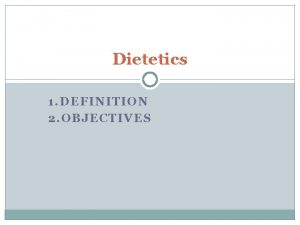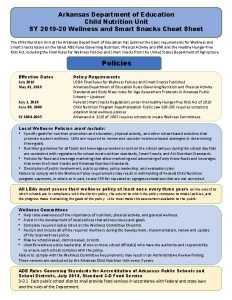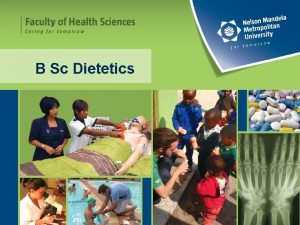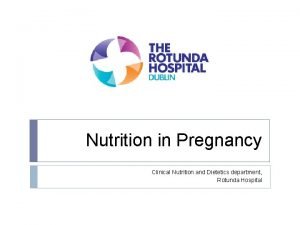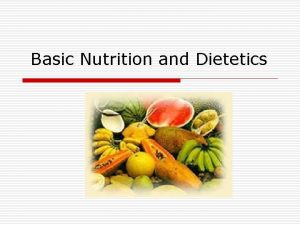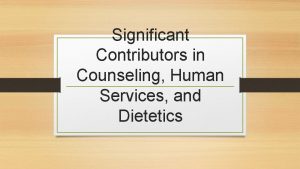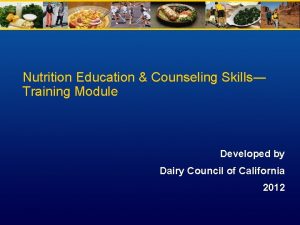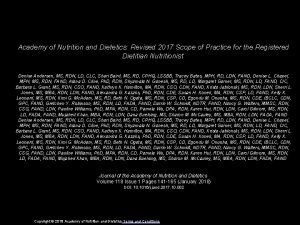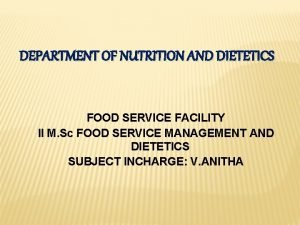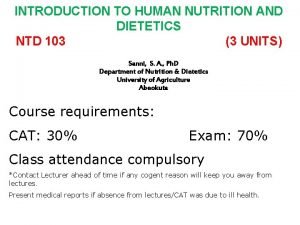Nutrition Counseling and Education Skills for Dietetics Professionals




















































- Slides: 52

Nutrition Counseling and Education Skills for Dietetics Professionals 6 th Edition Copyright © 2014 Wolters Kluwer Health | Lippincott Williams & Wilkins

Chapter 12 Implementing and Evaluating Learning Copyright © 2014 Wolters Kluwer Health | Lippincott Williams & Wilkins

Objectives • Explain the advantages and disadvantages of various educational methods and techniques • Discuss the educational methods and techniques appropriate in the cognitive, affective, and psychomotor domains • Compile a task analysis • List the ways in which instruction can be organized and sequenced • Identify the purposes of an educational evaluation Copyright © 2014 Wolters Kluwer Health | Lippincott Williams & Wilkins

Objectives (Con’t) • Explain several types of evaluation • Prepare a lesson plan • Compare and contrast formative and summative evaluations, norm-referenced and criterionreferenced evaluations, and reliability and validity • Plan, implement, and evaluate an educational presentation for a specific target audience Copyright © 2014 Wolters Kluwer Health | Lippincott Williams & Wilkins

“I hear and I forget, I see and I remember, I do and I understand. ” Confucius Copyright © 2014 Wolters Kluwer Health | Lippincott Williams & Wilkins

7 Steps to Effective Education (con’t from Chapter 11) • Step 4: Select methods, techniques, materials, resources • Step 5: Implement learning experiences (intervention) • Step 6: Evaluate progress & outcomes of leaning • Step 7: Document outcomes & results Copyright © 2014 Wolters Kluwer Health | Lippincott Williams & Wilkins

Step 4: Select Methods/Techniques • Instructor plans, organizes, presents information • Each method has advantages & disadvantages Copyright © 2014 Wolters Kluwer Health | Lippincott Williams & Wilkins

Lecture Method • Useful with large numbers & limited time • But learner is passive, only listening • No guarantee of behavior change • Not suitable for all objectives Copyright © 2014 Wolters Kluwer Health | Lippincott Williams & Wilkins

Discussion Method • More active learner; more interesting • Smaller groups (10 -15) • Seat in circle • More time consuming Copyright © 2014 Wolters Kluwer Health | Lippincott Williams & Wilkins

Simulation Method • Learning by doing – Ex: Scenarios, critical incidents, role playing • Requires critical thinking/problem solving • Connects theory and practice • Can be time consuming Copyright © 2014 Wolters Kluwer Health | Lippincott Williams & Wilkins

Demonstration Method • Demonstration by instructor • Realistic • Give learner chance to practice Copyright © 2014 Wolters Kluwer Health | Lippincott Williams & Wilkins

Visual & Audio-Assisted Instruction • Computer programs • Video conferencing • Videotape, DVD • Both visual & audio stimulation • An adjunct to learning Copyright © 2014 Wolters Kluwer Health | Lippincott Williams & Wilkins

Step 5: Techniques/Methods for Three Domains of Learning • Cognitive • Affective • Psychomotor Copyright © 2014 Wolters Kluwer Health | Lippincott Williams & Wilkins

Cognitive Domain Methods • Most methods are effective but most affective with mixed methods - Lecture not effective at higher levels in the domain Copyright © 2014 Wolters Kluwer Health | Lippincott Williams & Wilkins

Affective Domain Methods • Need learner involvement • Changing attitudes/values takes time • Guided discussion, inquiry learning, experiments • Solve problems, use audiovisuals • Model by observing others Copyright © 2014 Wolters Kluwer Health | Lippincott Williams & Wilkins

Psychomotor Domain Methods • Need direct experience • Demonstration • Repeated practice over time • Coaching Copyright © 2014 Wolters Kluwer Health | Lippincott Williams & Wilkins

Task Analysis: Job Related Tasks • Sequential list of steps in task • Put in writing • Used by trainer and trainee Copyright © 2014 Wolters Kluwer Health | Lippincott Williams & Wilkins

Job Instruction Training System • Four step process • Training on the job – Preparation step – Presentation step – Performance step – Follow up step Copyright © 2014 Wolters Kluwer Health | Lippincott Williams & Wilkins

Sequencing Instruction Promotes Learning • From general to specific • From specific to general • From familiar to unfamiliar • From simple to complex Copyright © 2014 Wolters Kluwer Health | Lippincott Williams & Wilkins

Sequencing Instruction (con’t) • Base on logic • Base on frequency of use of information • Base on interest/concerns of learner Copyright © 2014 Wolters Kluwer Health | Lippincott Williams & Wilkins

Step 6: Evaluation of Results • Evaluation: A systematic appraisal of the quality, effectiveness, and worth of an endeavor. • Compare quality/effectiveness to a standard • One forms value judgments Copyright © 2014 Wolters Kluwer Health | Lippincott Williams & Wilkins

Measurement/Educational Assessment • The process of collecting and quantifying data in terms of numbers of the extent, degree, or capacity of people’s learning in knowledge, attitudes, skills, performance, behavioral change. • Evaluation is based on measurement Copyright © 2014 Wolters Kluwer Health | Lippincott Williams & Wilkins

Testing • A kind of measurement • Determines degree to which a person possesses certain attributes Copyright © 2014 Wolters Kluwer Health | Lippincott Williams & Wilkins

Planning for Evaluation • Define objectives & outcomes • Design evaluation based on objectives • Choose what to evaluate • Decide how & when to collect data • Construct collection instrument Copyright © 2014 Wolters Kluwer Health | Lippincott Williams & Wilkins

Planning for Evaluation (con’t) • Implement data collection • Analyze results • Report results • Set new course of action Copyright © 2014 Wolters Kluwer Health | Lippincott Williams & Wilkins

Purposes of Evaluation • For determining effectiveness of program/training • For quality control • For planning and improvement • For justification Copyright © 2014 Wolters Kluwer Health | Lippincott Williams & Wilkins

Purposes of Evaluation (con’t) • Identify strengths/areas to improve • Show accountability • Tells if learning objectives achieved • Helps rediagnose learning needs Copyright © 2014 Wolters Kluwer Health | Lippincott Williams & Wilkins

Formative Evaluation • Occurs before or during learning • Use focus groups, interviews, surveys • Helps diagnose problems/improvements • Allows revising plans early • Qualitative Copyright © 2014 Wolters Kluwer Health | Lippincott Williams & Wilkins

Summative Evaluation • Assess at the end of learning activity • Appraises results, outcomes, quality, worth • Judges effectiveness of learning • Quantitative Copyright © 2014 Wolters Kluwer Health | Lippincott Williams & Wilkins

Norm-Referenced Method • Compares with group norm, typical performance • Used by schools • Less appropriate for adults Copyright © 2014 Wolters Kluwer Health | Lippincott Williams & Wilkins

Criterion-Referenced Method • Compares with predefined, objective standards • Shows what learner can/cannot do • Assesses according to performance objectives • More diagnostic Copyright © 2014 Wolters Kluwer Health | Lippincott Williams & Wilkins

Types of Evaluation/Outcomes • Select what to evaluate • May want to combine choices Copyright © 2014 Wolters Kluwer Health | Lippincott Williams & Wilkins

Measure Participant Reaction to Program/Activities • A happiness index • Subjective judgments of value of what learned or approaches used Copyright © 2014 Wolters Kluwer Health | Lippincott Williams & Wilkins

Measure Behavioral Change • In dietary behaviors/food choices/exercise • In employee performance • Has training transferred to the job? • More difficult to measure Copyright © 2014 Wolters Kluwer Health | Lippincott Williams & Wilkins

Measure Organizational Results • Quality and/or quantity of work done • Benefits to company • Efficiency/productivity/employee morale • Dollar savings that result Copyright © 2014 Wolters Kluwer Health | Lippincott Williams & Wilkins

Measure Learning – Cognitive, Affective, Psychomotor • Compare with performance objectives • Develop situations based on objectives • Attitudes/values difficult to measure Copyright © 2014 Wolters Kluwer Health | Lippincott Williams & Wilkins

Measure Other Outcomes • Psychosocial outcomes • Physiological/biological measures • Eating behavioral change based on self reports • Environmental/organizational changes Copyright © 2014 Wolters Kluwer Health | Lippincott Williams & Wilkins

Data Collection Techniques • Test • Questionnaires • Interviews and self-reports • Observation • Performance test and measures • Ratings and checklists Copyright © 2014 Wolters Kluwer Health | Lippincott Williams & Wilkins

1. Tests – Written & Oral – Ex: multiple choice, essay • Measure cognitive domain • Written tests less appropriate for adults Copyright © 2014 Wolters Kluwer Health | Lippincott Williams & Wilkins

2. Questionnaires • Assess attitudes & values • Assess cognitive objectives Copyright © 2014 Wolters Kluwer Health | Lippincott Williams & Wilkins

3. Interviews • Assess cognitive & affective objectives • Preplan the questions in advance Copyright © 2014 Wolters Kluwer Health | Lippincott Williams & Wilkins

4. Visual Observation • Define what to observe • Use observation checklist • Good for psychomotor objectives Copyright © 2014 Wolters Kluwer Health | Lippincott Williams & Wilkins

5. Performance Tests • Simulated or actual • Assess cognitive & psychomotor objectives Copyright © 2014 Wolters Kluwer Health | Lippincott Williams & Wilkins

6. Rating Scales/Checklists • Define all terms • Need to train evaluators Copyright © 2014 Wolters Kluwer Health | Lippincott Williams & Wilkins

7. Performance Measures • Individual or group measures Copyright © 2014 Wolters Kluwer Health | Lippincott Williams & Wilkins

8. Self-Reports/Self. Monitoring • May be distorted or inaccurate • Information may be missing Copyright © 2014 Wolters Kluwer Health | Lippincott Williams & Wilkins

Validity of Measurements • Do we measure what we intend to? • Content-related validity • Construct-related validity • Criterion-related validity Copyright © 2014 Wolters Kluwer Health | Lippincott Williams & Wilkins

Reliability Educational Outcomes • Consistency and accuracy over time Copyright © 2014 Wolters Kluwer Health | Lippincott Williams & Wilkins

Lesson Plans • Summary information about instruction • Pre-assessment/needs assessment • Performance objectives • Content outline (introduction, body, conclusion) • Sequence of content Copyright © 2014 Wolters Kluwer Health | Lippincott Williams & Wilkins

Lesson Plans (con’t) • Activities to reach objectives • Techniques/methods of instruction • Educational materials, visuals • Facilities; time allotted • Method to evaluate results/outcomes • References Copyright © 2014 Wolters Kluwer Health | Lippincott Williams & Wilkins

Step 7: Documentation • Mandated by JCAHO (Joint Commission) • In patient/client records • Document assessment, diagnosis, intervention, outcomes • Document in employee records Copyright © 2014 Wolters Kluwer Health | Lippincott Williams & Wilkins

PES Approach to Documentation • Problem (specific nutrition diagnosis) • Etiology or cause • Signs/symptoms • Document nutrition assessment, nutrition diagnosis, nutrition intervention, monitoring and evaluation Copyright © 2014 Wolters Kluwer Health | Lippincott Williams & Wilkins
 Objectives of dietetics
Objectives of dietetics Diploma in modern dietetics and ayurvedic nutrition
Diploma in modern dietetics and ayurvedic nutrition Idaho academy of nutrition and dietetics
Idaho academy of nutrition and dietetics Nutrition for foodservice and culinary professionals
Nutrition for foodservice and culinary professionals Nutrition for foodservice and culinary professionals
Nutrition for foodservice and culinary professionals Nutrition for foodservice and culinary professionals
Nutrition for foodservice and culinary professionals Dietetics ubc
Dietetics ubc Collaboration skills for school professionals
Collaboration skills for school professionals Training for higher education professionals
Training for higher education professionals Inter and intra personal skills
Inter and intra personal skills Hard skills examples
Hard skills examples Arkansas child nutrition unit
Arkansas child nutrition unit Arkansas department of education child nutrition unit
Arkansas department of education child nutrition unit Cacfp nebraska
Cacfp nebraska Society of competitive intelligence professionals
Society of competitive intelligence professionals Families professionals and exceptionality
Families professionals and exceptionality Ctip clause that must be included in every contract
Ctip clause that must be included in every contract Families professionals and exceptionality
Families professionals and exceptionality Kontinuitetshantering i praktiken
Kontinuitetshantering i praktiken Novell typiska drag
Novell typiska drag Nationell inriktning för artificiell intelligens
Nationell inriktning för artificiell intelligens Vad står k.r.å.k.a.n för
Vad står k.r.å.k.a.n för Shingelfrisyren
Shingelfrisyren En lathund för arbete med kontinuitetshantering
En lathund för arbete med kontinuitetshantering Särskild löneskatt för pensionskostnader
Särskild löneskatt för pensionskostnader Vilotidsbok
Vilotidsbok Anatomi organ reproduksi
Anatomi organ reproduksi Förklara densitet för barn
Förklara densitet för barn Datorkunskap för nybörjare
Datorkunskap för nybörjare Boverket ka
Boverket ka Tes debattartikel
Tes debattartikel Autokratiskt ledarskap
Autokratiskt ledarskap Nyckelkompetenser för livslångt lärande
Nyckelkompetenser för livslångt lärande Påbyggnader för flakfordon
Påbyggnader för flakfordon Formel för lufttryck
Formel för lufttryck Offentlig förvaltning
Offentlig förvaltning Kyssande vind analys
Kyssande vind analys Presentera för publik crossboss
Presentera för publik crossboss Teckenspråk minoritetsspråk argument
Teckenspråk minoritetsspråk argument Bat mitza
Bat mitza Klassificeringsstruktur för kommunala verksamheter
Klassificeringsstruktur för kommunala verksamheter Mjälthilus
Mjälthilus Claes martinsson
Claes martinsson Centrum för kunskap och säkerhet
Centrum för kunskap och säkerhet Verifikationsplan
Verifikationsplan Mat för idrottare
Mat för idrottare Verktyg för automatisering av utbetalningar
Verktyg för automatisering av utbetalningar Rutin för avvikelsehantering
Rutin för avvikelsehantering Smärtskolan kunskap för livet
Smärtskolan kunskap för livet Ministerstyre för och nackdelar
Ministerstyre för och nackdelar Tack för att ni har lyssnat
Tack för att ni har lyssnat Referatmarkeringar
Referatmarkeringar Redogör för vad psykologi är
Redogör för vad psykologi är
